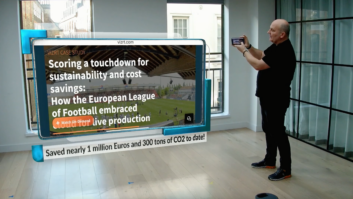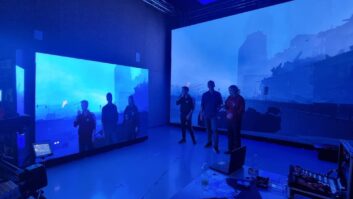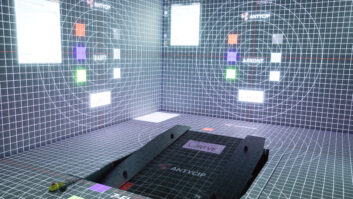
Extended Reality – also called Cross Reality by some commentators – is by no means a fully defined term, with differing opinions as to what it encompasses. Some see it as an umbrella description for VR and AR. Others include standards such as immersive and 360° video and projection mapping. And there is also confusion as to whether Mixed or Merged Reality (MR) is an alternative moniker or merely one of XR’s components.
Jim Malcolm, general manager of visual innovation specialists HumanEyes Technologies was very clear on how he categorises XR when he told Wired magazine: “XR does not refer to any specific technology. It’s a bucket for all of the realities.” For Jim, these include AR, VR and MR.
Certainly, XR is not a new term, having been used as far back as the 60s, when photographic innovator Charles Wyckoff filed a patent for an XR film to allow people to view things beyond regular human vision, as a result of developing techniques to photograph atomic experiments in the Pacific Ocean. Not then the same interactive, reality-warping definition we think of over half a century on, but still an ‘extension’ of reality through the use of expansive technology.
Big part
“XR is a broad term, without clear definition in my opinion, that collects MR, VR and AR into one group,” explains Emma Bigg, director at consultants Octavius RE.
“I think what XR really means is that we will have a convergence of technology where different layers can be accessed, depending on the equipment and software you have. I think XR has a big part to play in the world of AV installations, in terms of creating better experiences and connecting people.”
VR, AR and MR are certainly making inroads into the various AV-heavy sectors – particularly as a result of new and more widely accessible hardware, such as the latest VR headsets.
“New VR headsets address concerns such as robustness and durability,” says Linda Duggan, Portfolio Manager, Holovis. “They are wireless to eliminate cables, feature inside/out tracking to remove external hardware, and are of a higher quality resolution – making them more suitable for markets such as advanced engineering and virtual manufacturing, where precision is everything.”
Duggan believes that the future lies in MR, rather than the broader XR, but that hardware still has a way to go to enable proper collaboration in a non-invasive way, with effective real-time tracking of the operator’s environment. “At the moment, MR is mixed at device level, but true Mixed Reality with AR and an analysis of the real world within the same view, coupled with simple and unconstructive form-factor hardware, will hopefully start to deliver the capabilities industry are looking for and drive wider adoption.”
“All of these elements and more are moving forward at an incredible pace and creating new and exciting opportunities in their wake”
Simon Benson, Realised Realities
Whatever terminology you choose to use, it’s clear that XR and its component technologies have huge potential in the working environment, with benefits to corporate meetings, building projects and even oil rig work. The scope is huge.
Developing tools
“The tools are developing quickly and could soon be deployable at scale, opines Christian Bozeat, Director, MACOM GMBH (UK). “We are, however, in the early adopter part of the life cycle, with only a few taking on the challenges of working through the use cases and creating business cases for the deployments.”
The difficulty, says Bozeat, is that most companies still don’t have a strategy for designing, deploying and supporting ‘standard’ AV systems properly yet – let alone XR ones – and many don’t even take seriously the internal research and development required for these systems to work. “There is an opportunity for XR to leapfrog standard AV in some areas as it could present substantial savings in construction and installation, as well as support for some applications,” he says. “But there is a cultural and working process challenge that also needs to be addressed.”
These concerns aside, XR has certainly seen strong growth and growing support from the major corporations, perhaps suggesting that it is a technology grouping that is here to stay, and embed into the broader AV tech sandbox.
Simon Benson, founder of Realised Realities, believes that the significant areas to watch in AV are immersive video, positional audio and production tooling. “All of these elements and more are moving forward at an incredible pace and creating new and exciting opportunities in their wake,” he says. “So it is clear that there is a bright future ahead for XR in the AV field.”
Of course, it’s the office and within higher education – in terms of meetings and collaboration – that many see as the great hope for a broader, less specialist, acceptance of XR. “We are 110% convinced that interactive immersive environments will progressively complement and supplement the use of VR and XR headsets, smart glasses, mobiles and flat screens – both in enterprise and education,” says Jake Rowland, Head of Business Development, Igloo Vision.
Unsurprisingly, Rowland believes that the best way of achieving this immersive working evolution is with the use of immersive environments such as Igloo Vision’s own 360° domes – rather than regular boardroom and lecture theatre environments.
Indeed, tech research and advisory expert Gartner has started mentioning such immersive workspaces in its reports as a technology CIOs should be actively investigating in 2020. And global service provider NTT mentions immersive, responsive ‘phygital’ spaces – where the physical world blends with the digital – in its Future Disrupted technology predictions for 2020.
www.holovis.com
www.macom.de/en
www.octaviusre.com
www.realisedrealities.com







